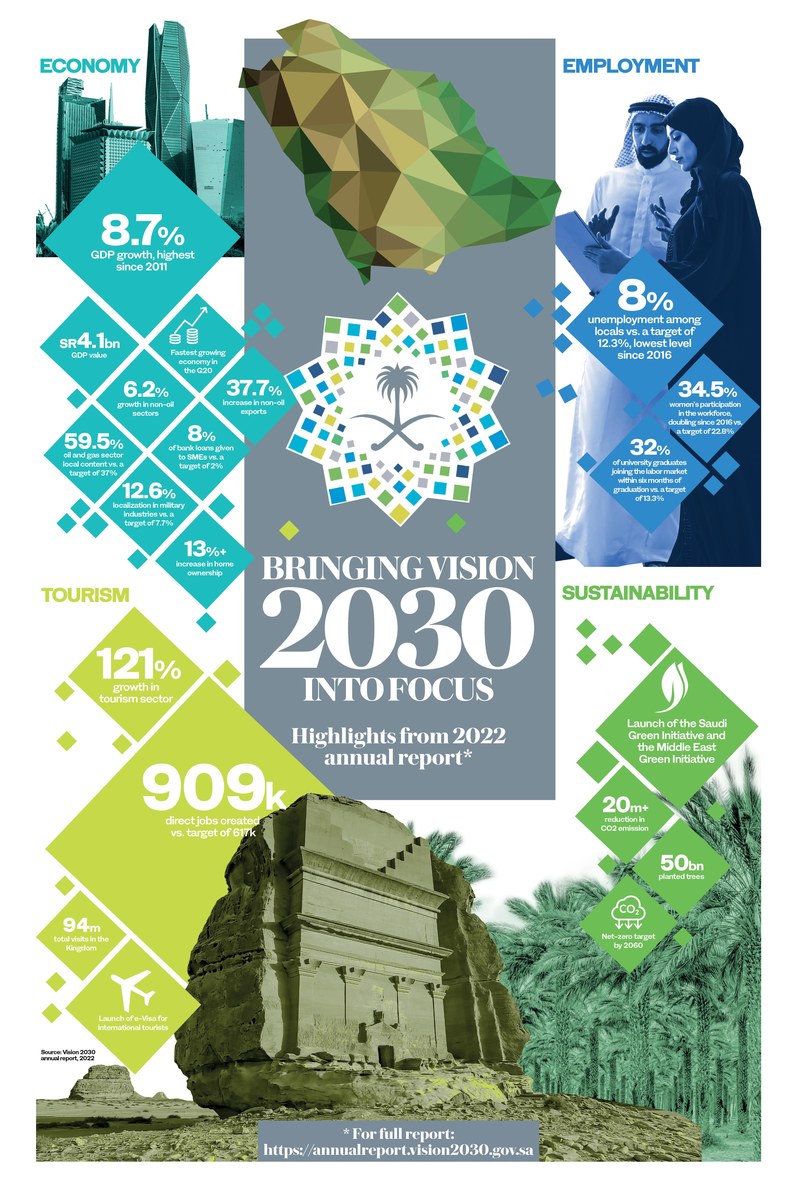RIYADH: Saudi Arabia’s Vision 2030 plan to diversify the Kingdom’s economy is ahead of many of its targets as it picks up momentum, according to an annual report which monitors the progress of the plan.
The Kingdom’s achievements throughout 2022 across various sectors show it is outpacing a number of the goals outlined in Vision 2030, the document reveals.
This cements Saudi Arabia’s diversification efforts as it seeks to wean its economy off oil production and exports.
Economic transformation
Despite the complex economic conditions and challenges experienced across the world, the Saudi economy is growing at an unprecedented pace.
In 2022, the Kingdom’s economy consistently exceeded the expectations of the International Monetary Fund and was ranked as the fastest-growing economy in the world.
During the same year, the Kingdom recorded an 8.7 percent growth rate in real gross domestic product compared to 2021, reflecting the highest growth rate among the G20 countries and the highest national growth rate since 2011.
In addition to this, the value of GDP at current prices hit SR4.1 billion ($1.09 billion), reflecting a growth of 27.6 percent when compared to a year earlier.
Saudi Arabia also achieved 59.5 percent of local content — the percentage of goods, services, and skills sourced from local suppliers — in the oil and gas sector as opposed to the targeted baseline of 37 percent in 2022.
The aim of promoting local content is to increase the participation of local businesses and citizens in the industry’s supply chain, which can lead to economic growth, job creation and technology transfer.
According to the report, the Kingdom also surpassed its targets for the share of non-oil exports in non-oil GDP by 6.3 percentage points, coming in at 25 percent in 2022.
Small and medium enterprises loans as a percentage of bank loans also outscored the baseline target of 2 percent last year by attaining 8 percent.
Employment conditions
New created job opportunities in the country resulted in a significant decrease in the unemployment rate among Saudis, which reached 8 percent in the fourth quarter of 2022, down from 11 percent in 2021.
This confirms the high rate of participation of locals in the labor force, the attractiveness of the labor market, and its role in hiring, as well as absorbing, national cadres.
The report further revealed that the percentage of university graduates joining the labor market within six months of their graduation reached 32 percent against the targeted 13.3 percent.
With regards to the percentage of workers with special needs in the market, it registered 12.4 percent compared to the targeted 7.7 percent.
Women’s participation in the labor market doubled since 2016 to reach 34.5 percent in 2022, surpassing the set target of 22.8 percent.
The reforms undertaken by the government to empower Saudi women contributed to raising their participation in administrative positions to 41.1 percent by the end of 2022.
The Kingdom was among the top three improving countries in the world in terms of bridging the gender. It was also recognized as the best reformer in the field of women’s empowerment by the World Bank.

Tourism overview
The Kingdom is witnessing a remarkable boom in tourism, as the sector grew by 121 percent in 2022, making it the fastest-growing destination in the G20, compared to the global average before COVID-19.
Saudi Arabia saw 94 million tourists within its borders during 2022 — 16.5 million of which were from abroad while 77.6 million were residents.
As many as 909,000 direct jobs were created in the tourism sector, exceeding the 2022 target of 617,000 by 139 percent.
Sustainability targets
With the Kingdom being a leading country in oil production, Vision 2030 is working on mitigating the impact of climate change while stimulating the so-called green era.
Through the launch of the Saudi Green Initiative and the Middle East Green Initiative, Saudi Vision 2030 ensured that sustainability and environmental preservation are a solid foundation in its development plans and major projects.
The Middle East Green Initiative has constituted a roadmap for achieving a more sustainable and green future, not only for the Kingdom, but also for the region and the world as a whole.
Under this plan, Saudi Arabia reported the planting of an estimated 50 billion trees in 2022, and during the same period the area covered by trees across the Kingdom surged by 12 times.
Moreover, the Kingdom managed to reclaim 200 million hectares of degraded land, a move which is expected to contribute to the reduction of 2.5 percent of global emissions.
All of this helps the Kingdom’s greater objective of achieving net zero carbon emissions by 2060.
Writing in the report King Salman said: “Our history records the greatest and most successful collection of directed purposes to building a modern state whose foundation is the citizen, its pillar is development, and its goal is prosperity.”
Crown Prince Mohammed bin Salman added: “The future of the Kingdom is blessed and promising. Our country deserves more than what has been achieved.
“We have capabilities; we will double their role and increase their contribution in making this future.”













